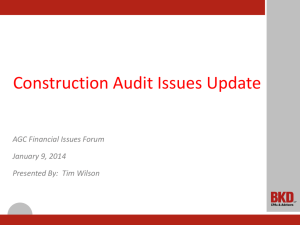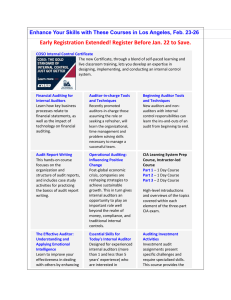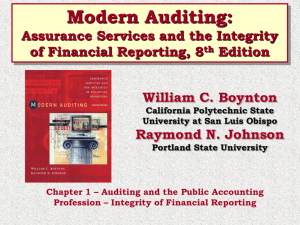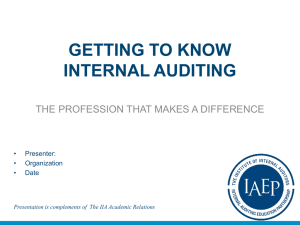Auditing reborn
advertisement
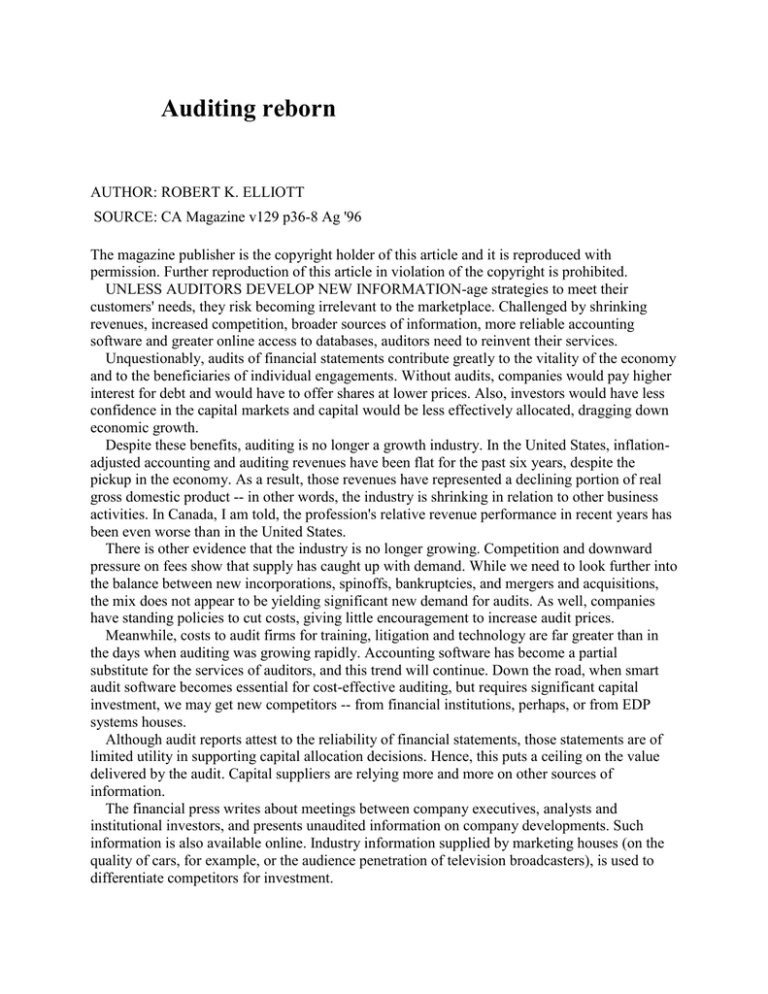
Auditing reborn AUTHOR: ROBERT K. ELLIOTT SOURCE: CA Magazine v129 p36-8 Ag '96 The magazine publisher is the copyright holder of this article and it is reproduced with permission. Further reproduction of this article in violation of the copyright is prohibited. UNLESS AUDITORS DEVELOP NEW INFORMATION-age strategies to meet their customers' needs, they risk becoming irrelevant to the marketplace. Challenged by shrinking revenues, increased competition, broader sources of information, more reliable accounting software and greater online access to databases, auditors need to reinvent their services. Unquestionably, audits of financial statements contribute greatly to the vitality of the economy and to the beneficiaries of individual engagements. Without audits, companies would pay higher interest for debt and would have to offer shares at lower prices. Also, investors would have less confidence in the capital markets and capital would be less effectively allocated, dragging down economic growth. Despite these benefits, auditing is no longer a growth industry. In the United States, inflationadjusted accounting and auditing revenues have been flat for the past six years, despite the pickup in the economy. As a result, those revenues have represented a declining portion of real gross domestic product -- in other words, the industry is shrinking in relation to other business activities. In Canada, I am told, the profession's relative revenue performance in recent years has been even worse than in the United States. There is other evidence that the industry is no longer growing. Competition and downward pressure on fees show that supply has caught up with demand. While we need to look further into the balance between new incorporations, spinoffs, bankruptcies, and mergers and acquisitions, the mix does not appear to be yielding significant new demand for audits. As well, companies have standing policies to cut costs, giving little encouragement to increase audit prices. Meanwhile, costs to audit firms for training, litigation and technology are far greater than in the days when auditing was growing rapidly. Accounting software has become a partial substitute for the services of auditors, and this trend will continue. Down the road, when smart audit software becomes essential for cost-effective auditing, but requires significant capital investment, we may get new competitors -- from financial institutions, perhaps, or from EDP systems houses. Although audit reports attest to the reliability of financial statements, those statements are of limited utility in supporting capital allocation decisions. Hence, this puts a ceiling on the value delivered by the audit. Capital suppliers are relying more and more on other sources of information. The financial press writes about meetings between company executives, analysts and institutional investors, and presents unaudited information on company developments. Such information is also available online. Industry information supplied by marketing houses (on the quality of cars, for example, or the audience penetration of television broadcasters), is used to differentiate competitors for investment. It is no secret that intangible assets unrecognized by today's GAAP play a greater role than ever before in determining profitability and future success. And that role is growing. Two years ago, the AICPA Special Committee on Financial Reporting (the Jenkins committee) pointed to ways in which financial reporting could be improved. Relying on direct evidence from financial statement users about their information needs, it found those needs unmet by current GAAP. As Exhibit 1 illustrates, investors are relying less and less on financial statements as a source of information for decision-making purposes. LOOKING TO THE FUTURE What is the basis for projecting that, without intervention, audited financial statements will play an ever-declining role in investment decision-making? The primary factor is the way in which computers and telecommunications are transforming the information marketplace. Information technology allows for more timely reports and presents an opportunity for direct, real-time access to data. This would allow investors and creditors to have access to selected parts of corporate databases, and create their own reports using the software of their choice. For example, investors and creditors have made it clear that they want better segment information. If they had online access to the databases of investees and potential investees, they would be able, with purchased or developed software, to report segment data in the way they consider most useful for their analyses. The arguments about how best to report segments for general-purpose reporting would fall by the wayside. Investors would create accounting reports dovetailed to their decision-making needs, whether those needs were segmentation by geography, production unit, major products or services, administrative divisions, or some other concept. Much of what we now call accounting would be performed by the users of the information, or by new intermediaries that would arise in the marketplace to meet users' needs. Accounting standards would focus on defining data elements and structures and perhaps security procedures. Rather than assembling and delivering information to investors, accountants would create order and control for online access to information. Long-term trends suggest this will happen. Networked computers are proliferating and the cost of capturing, processing and reporting data continues to decline. For managerial purposes, reports would be available in real time, so reports to networked investors could also be made in real time. A natural extension of these arrangements would be for selected portions of databases to be opened to investors. One barrier to widespread access to databases is the legitimate fear that such information will help competitors. It is the same fear that inhibits organizations from making certain disclosures today. However, competitively sensitive information could be screened, and the trend toward reduced cycle times for new products and services would dampen the risks of competitive disadvantage. Corporate desires for an improved cost of capital and good shareholder relations would also weigh against any perceived risks. Opening databases selectively to networked parties is not an unlikely development; it is analogous to what analysts do today. They create their own reports based on data supplied by corporations and garnered from online and other sources. These sources provide a much more comprehensive view than that offered by GAAP financial statements. If we think of investors and creditors as capital suppliers, with relationships to corporate customers similar to those of other suppliers, the trend toward database access is already under way. Companies and suppliers linked by Electronic Data Interchange (EDI) have access to parts of each other's databases and may transfer purchase orders, receiving documents and invoices by electronic means. The first set of standards for data interchanges was published for the transportation industry in 1975. Generic standards -- which are not industry specific -- followed in 1988. Published by the American National Standards Institute, they are now widely followed in North America. TAILORED PRODUCTS Since information technology has changed traditional supply-demand relationships, we must ask how it will change the relationship between audit customers and auditors. In the most successful parts of the business world, suppliers' information about customer needs and desires is abundant and regularly refreshed. Inventory data are used for marketing, not just supply; focus and user groups are routine devices. The result is a proliferation of products and services closely earmarked to customers' changing tastes and needs. Where does the audit service stand when measured against such a trend? It is a generalized, one-size-fits-all product, in no way tailored to differences in the needs of investors, creditors and other users. It is true that we refine procedures and change standards, but that changes only the inputs. The output -- what audit report readers rely upon -- is basically an opinion on compliance with GAAP. Although responding to individual customer needs is one of the main messages of the past decade of economic change, the audit report is the same as it has been for generations. What product will the auditor supply in the coming world of advanced information technology, with database access, more reliable information from accounting software, and full electronic commerce? Today's audit report is delivered weeks or even months after the balance sheet date. Who will want to see such a report 10 years from now? Certainly not online investors and creditors who have real-time access to corporate databases, and not even readers of real-time business reports made available online by corporations. A CONCERTED RESPONSE Both in Canada and the United States, professional organizations have established groups charged with the task of broadening the traditional audit/attest function. The CICA has created the Board of Governors Task Force on Assurance Services, and the AICPA has created the Special Committee on Assurance Services, which I chair. In both cases, the focus is on creating more value for the customer. The CICA and the AICPA are cooperating in their tasks. The AICPA's special committee has benefited especially from the participation of several CICA members in both its deliberations and its subcommittee work. I am not going to detail the special committee's work, but I do want to present our definition of assurance services, our approach, some findings and the opportunities they present. The committee's tentative definition of assurance services is broad. Unfortunately, the term is the same as that used in the CICA's exposure draft, "Standards for assurance engagements," but the definition is different. Let's put the discrepancy aside, however, and focus only on the breadth-of-service issue. The AICPA committee developed this working definition: Assurance services are independent professional services that improve the quality of information, or its context, for decision-makers. The definition identifies the customer (the decision-maker) and the benefit the service provides to the customer (improved quality in decision-making information). It sets no limit on the type of information, which can be financial or nonfinancial, about performance or conditions. And the definition sets no limit on the type of quality improvement. The assurer can provide improved reliability or improved relevance. The definition is the first element of the committee's customer-first approach. The second element is research, which focuses on the information needs of decision-makers. Exhibit 2 shows the customers (vertical axis), the categories of decisions they make (horizontal axis), and the potential for assurance work (the shaded cells, which indicate not only that the parties make the decisions, but also that they do so with sufficient frequency to offer a potential market). In-depth interviews revealed unmet needs for information. Among the needs in the commercial sector were: * Information about the competence and integrity of management. * Information about the quality of internal systems as a measure of the implicit reliability of information used. * Information about the quality of products and services sold and purchased. * Information about risks and risk management. * Future-oriented information. * Comparison of results to strategic plans. * Tools for reducing the time and cost of data-gathering and decision-making. Who is going to supply such information? Who is going to establish its credibility so that decision-makers are confident in using it? Will new measurement criteria be needed? Can old accountancy services be applied or adapted to these potential markets, or will new ones be necessary? The same questions must be asked of the changing marketplace -- the evolving environment of electronic commerce, networked computing, online users and database access for investors and creditors. Here the opportunities grow, as do the challenges to the traditional role of independent accountants. Will the environment of advanced information technology make auditing obsolete or will it transform the service? Will auditors learn to perform real-time verifications, to provide assurance on advanced systems, and to report over networks? Will we see a day when the audit fee is based on users' demand for the report, as determined by the number of users who dial in to entity databases? In this scenario, there would be no audit report without the user expressing a desire to see one, perhaps in response to an online dialog box. Frequency of use would determine the fee. I will give one example of the opportunities presented by these evolving conditions in our markets. Electronic commerce, as we have seen, is coming. Customers and suppliers across the world will be wired up, and online transactions will take place routinely (except, of course, for the physical delivery of goods and noninformational services). In such a world, there will be all sorts of new needs for assurance. What Kevin Kelly described as the requirements for an online civilization (see Out of Control, Reading, Massachusetts, Addison-Wesley Publishing Company, 1995, p. 208) applies as well to electronic commerce. We will need online: * Anonymity. * Trust holders. * Identification. * Signatures. * Authentication. * Privacy. * Reputations. * Access. Assurers could play a role in guaranteeing every one of these prerequisites to electronic commerce -- but only if the services were developed and competencies supplemented as necessary. We should keep in mind that there is nothing unique about our industry's position. Every day, other types of businesses must face the challenges of waning markets and mature products. In response, they revise their processes and product lines, and go on to new successes. Auditors can too, if they are as realistic and creative as they have been in the past. Long ago, auditors created their own industry from scratch -- a far more difficult task. They can reinvent that industry now if they devote their energies and imagination to the job. As you know, my conclusions are based primarily on US data and experiences, and you are right to take out your discounting tools. You will have to weigh the similarities between the Canadian and US economies and the "interconnectedness" of global trends. Give critical attention to the CICA's efforts and participate in its work. In every country, our future success will depend on our savvy, our drive, and our grasp. Added material Robert K. Elliott, CPA, is assistant to the chairman of KPMG-US and chairman of the AICPA Special Committee on Assurance Services. Department Editor: David Scott, CA Price Waterhouse
